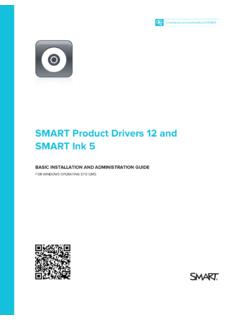Transcription of 8 Personal selling skills - Arif Sari
1 8 Personal selling skills buying signals closing the sale demonstrations needs analysis negotiation objections Personal selling skills reference selling sales presentation trial closeO B J E C T I V E SAfter studying this chapter, you should be able the various phases of the selling different questions to different selling what is involved in the presentation and the how to deal with buyers and apply the art of a saleK E Y C O N C E P T SSales basic philosophy underlying the approach to Personal selling adopted in thisbook is that selling should be an extension of the marketing concept. This impliesthat for long-term survival it is in the best interests of the salesperson and their com-pany to identify customer needs and aid customer decision-making by selectingfrom the product range those products that best fit the customer s requirements.
2 Thisphilosophy of selling is in line with Weitz1and the contingency framework, whichsuggests that the sales interview gives an unparalleled opportunity to match behav-iour to the specific customer interaction that is encountered. This is called adaptiveselling since the salesperson adapts their approach according to the specific situa-tion and it has been found to be a growing way of conducting sales is supported by research by Jaramillo et al.(2007) which showed thatadaptive selling was associated with salespeople s performance (as measured bytheir attainment of sales quotas).3 This is not to deny the importance of Personal per-suasion. In the real world, it is unlikely that a product has clear advantages over itscompetition on all points, and it is clearly part of the selling function for the sales-person to emphasise those superior features and benefits that the product , the model for Personal selling advocated here is that of a salespersonacting as a need identifier and problem-solver.
3 The view of the salesperson as beinga slick, fast-talking confidence trickster is unrealistic in a world where most sellersdepend on repeat business and where a high proportion of selling is conducted withprofessional and Weitz (1982) defined customer orientated selling as the degree to whichsalespeople practice the marketing concept by trying to help their customers makepurchase decisions that will satisfy customer needs .4 They characterised customerorientated selling desire to help customers make satisfactory purchase customers assess their products that will satisfy those products deceptive or manipulative influence the use of high pressure sales order to foster customer orientated selling , companies need to develop a corpo-rate culture that views understanding customers and creating value for them asbeing central to their philosophy, and to use evaluation procedures that includemeasurement of the support given to customers, customer satisfaction with salesper-son interactions, and the degree to which salespeople are perceived by customers tobehave ethically.
4 In addition, companies should include ethics in sales trainingcourses, and employ sales managers who are willing to promote and enforce ethicalcodes and studies6have shown that successful selling is associated with the following: asking questions; Personal selling skills249 providing product information, making comparisons and offering evidence tosupport claims; acknowledging the customer s viewpoint; agreeing with the customer s perceptions; supporting the customer; releasing tension; having a richer, more detailed knowledge of customers; increased effort; and confidence in one s own important findings should be borne in mind by salespeople when in a salesinterview. They also suggest that sales training can improve sales performance, notonly by improving skills , but by enhancing the self-confidence of the trainees in theirperceived ability to perform developing their Personal selling skills , salespeople should also be awareof the characteristics desired of salespeople by buyers.
5 Research has shown a numberof key factors and these are displayed in Table with the development of all skills , the theoretical approach described in thischapter needs to be supplemented by practical experience. Many companies userole playing to provide new salespeople with the opportunity to develop theirskills in a situation where sales trainees can observe and correct behaviour. Anexample of such an exercise is given at the end of Chapter order to develop Personal selling skills it is useful to distinguish seven phasesof the selling process, shown in Figure These phases need not occur in the ordershown. Objections may be raised during presentation or during negotiation and atrial close may be attempted at any point during the presentation if buyer interest ishigh. Furthermore, negotiation may or may not take place or may occur during anyof the stages.
6 As Moncrief and Marshall (2005) report:8 The evolved selling process assumes that the salesperson typically willperform the various steps of the process in some form, but the steps (phases)do not occur for each sales call. Rather, they occur over time, accomplishedby multiple people within the selling firm, and not necessarily in any characteristics of salespeople desired by buyers Expertise in their company s products and the market Good communication skills Ability to solve problems Ability to understand and satisfy the buyer s needs Thoroughness Ability to help in ensuring the reliable and fast delivery of ordersSource: Based on Garver, and Mentzer, J. T. (2000) Salesperson logistics expertise: a proposed contingency frame-work , Journal of Business Logistics, 21 (2) pp. 113 32; and Williams, and Seminerio, J. (1985) What buyers like fromsalesmen , Industrial Marketing Management, 14 (2), pp.
7 75 technique250 Dealing with objectionsFigure Personal selling OPENINGI nitial impressions can cloud later perceptions, so it is important to consider theways in which a favourable initial response can be expect salespeople to be businesslike in their Personal appearance andbehaviour. Untidy hair and a sloppy manner of dress can create a lack of , the salesperson who does not respect the fact that the buyer is likely to be abusy person, with many demands on their time, may cause irritation on the part ofthe should open with a smile, a handshake and, in situations where theyare not well known to the buyer, introduce themselves and the company they repre-sent. Common courtesies should be followed. For example, they should wait for thebuyer to indicate that they can sit down or, at least, ask the buyer if they may sitThe openingNeed and problem identificationPresentation and demonstrationNegotiationClosing the saleFollow-upPersonal selling skills251down.
8 Attention to detail, such as holding one s briefcase in the left hand so that theright can be used for the handshake, removes the possibility of an awkward momentwhen a briefcase is clumsily transferred from right to left as the buyer extends theirhand in remarks are important since they set the tone for the rest of the sales in-terview. Normally they should be business-related since this is the purpose of thevisit; they should show the buyer that the salesperson is not about to waste the buyer is well known and by their own remarks indicates a willingness totalk about a more social matter, the salesperson will obviously follow. This can gen-erate close rapport with the buyer, but the salesperson must be aware of the reasonfor being there and not be excessively diverted from talking business. Openingremarks might be:Trade salesperson:Your window display looks attractive.
9 Has it attracted morecustom?Industrial salesperson:We have helped a number of companies in the same kind ofbusiness as you are in to achieve considerable savings by theuse of our stock control procedures. What methods do youuse at present to control stock?Retail salesperson:I can see that you appear to be interested in our stereoequipment. What kind of system do you have in mind?The cardinal sin which many retail salespeople commit is to open with Can I helpyou? which invites the response No thank you. I m just looking. The use of the internet can help to create favourable first impressions. For exam-ple, research using online business databases can make the salespeople appear moreknowledgeable about the customer s company and AND PROBLEM IDENTIFICATIONMost salespeople have a range of products to sell. A car salesperson has many modelsranging from small economy cars to super luxury top-of-the-range models.
10 The com-puter salesperson will have a number of systems to suit the needs and resources ofdifferent customers. A bicycle retailer will have models from many different manufac-turers to offer customers. A pharmaceutical salesperson will be able to offer doctorsa range of drugs to combat various illnesses. In each case, the seller s first objectivewill be to discover the problems and needs of the customer. Before a car salespersoncan sell a car, they need to understand the customer s circumstances. What size ofcar is required? Is the customer looking for high fuel economy or performance? Isa boot or a hatchback preferred? What kind of price range is being considered?Having obtained this information the salesperson is in a position to sell the modelbest suited to the needs of the buyer. A computer salesperson may carry out a sur-vey of customer requirements prior to suggesting an appropriate computer bicycle retailer should ask who the bicycle is for, what type is preferred ( or racing) and the colour preference, before making sensible suggestionsSales technique252as to which model is most suitable.







